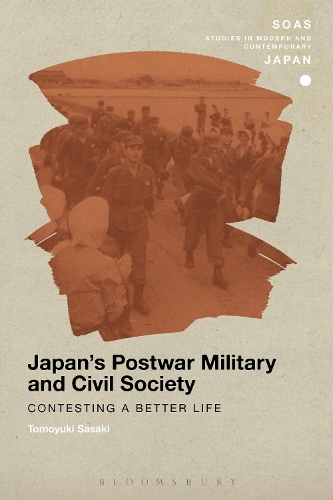
Japan's Postwar Military and Civil Society: Contesting a Better Life
(Hardback)
Available Formats
Publishing Details
Japan's Postwar Military and Civil Society: Contesting a Better Life
By (Author) Tomoyuki Sasaki
Bloomsbury Publishing PLC
Bloomsbury Academic
27th August 2015
United Kingdom
Classifications
Tertiary Education
Non Fiction
Asian history
355.033052
Physical Properties
Hardback
224
Width 156mm, Height 234mm
494g
Description
Japan's so-called 'peace constitution' renounces war as a sovereign right of the nation, and bans the nation from possessing any war potential. Yet Japan also maintains a large, world-class military organization, namely the Self-Defence Forces (SDF). In this book, Tomoyuki Sasaki explores how the SDF enlisted popular support from civil society and how civil society responded to the growth of the SDF. Japan's Postwar Military and Civil Society details the interactions between the SDF and civil society over four decades, from the launch of rearmament in 1950. These interactions include recruitment, civil engineering, disaster relief, anti-SDF litigation, state financial support for communities with bases, and a fear-mongering campaign against the Soviet Union. By examining these wide-range issues, the book demonstrates how the militarization of society advanced as the SDF consolidated its ideological and socio-economic ties with civil society and its role as a defender of popular welfare. While postwar Japan is often depicted as a peaceful society, this book challenges such a view, and illuminates the prominent presence of the military in people's everyday lives.
Reviews
Stimulating ... A fascinating book which sheds light on an important yet understudied subject. The amount of previously unexamined primary sources in Japanese that the book employs is also very impressive. Finally, Sasaki's approach to militarization and to the civil-military interdependence is thought provoking. * Japan Review *
Sasaki (Eastern Michigan Univ.) focuses his study on the integration of the Japan Self-Defense Forces (SDF) into Japanese civil society from its creation in the early 1950s to the mid-1990s. He provides good case studies on aspects of the interaction between the SDF and society, including recruitment, civil engineering, disaster relief, state financial support for communities with bases, propaganda campaigns, etc. These topics have not received attention in previous studies of the SDF, so this book makes a valuable contribution. Summing Up: Recommended. Upper-division undergraduates and above. * CHOICE *
Sasaki presents a comprehensive analysis of the interdependence of the SFD and the local population of Hokkaido from a grass-roots perspective. In addition to statistical material he draws on the notes of SDF members as well as on literary works. This variety of sources guarantees an informative read. * Neue Politische Literatur (Bloomsbury translation) *
This study of the SDF in Japan differs from others in focusing on the integration of military forces into Japanese civil society in the postwar period. The book is informed by broad, theoretical analysis throughout. The chapters balance larger theoretical analyses with specific historical examples in a highly readable account. Although many of the historical conditions are specific to Japan, Sasakis analysis of the general historical processes should be widely applicable to many other locales. * Wesley Sasaki-Uemura, University of Utah, USA *
Tomoyuki Sasaki surveys the move from Japans total demilitarisation in 1945, to the creation of a police reserve, the creation of a Self Defence Force (Jieitai), and the increasing integration of the Jieitai into selected local communities. Despite immense popular support for the retention of Article 9 of the Constitution of Japan, which renounces belligerence, the Jietai continues to play an important, albeit contested, role in Japanese civil society. Its existence challenges the notion of a pacifist Japan. Tomoyuki Sasakis examination of the historical development of the Jieitai and its imbrication in local communities is particularly timely, and can help inform contemporary debates on pacifism and militarism. * Vera Mackie, University of Wollongong, Australia *
Author Bio
Tomoyuki Sasaki is Associate Professor of Japanese Studies at the College of William and Mary, USA.
